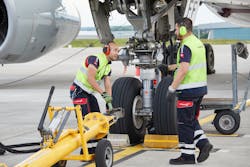How the IGOM Portal Improves Communication
The IATA Ground Operations Manual (IGOM) has established itself as a global industry standard for ground handling operations worldwide. Recently, the International Air Transport Association (IATA) has launched the IGOM Portal as a further enabler of IGOM adoption.
“The IGOM Portal is an online platform where, with IGOM as the primary reference, airlines and ground service providers (GSPs) can exchange information, including any variations, on their ground handling requirements,” say IATA officials.
Adoption Status
According to Swissport, airlines have indeed started to adopt IGOM widely.
“We have adopted the IGOM for ground handling procedures. Industry wide adoption of IGOM is a key driver to standardization and simplification of procedures which, in turn, supports the drive for a safer work environment,” officials at Swissport say.
Before the launch of the IGOM Portal, conformance to IGOM was tracked for IATA Operational Safety Audit (IOSA) airlines and for ground handling service providers (GHSPs) through recommended practices that are part of the audit standards during IOSA and ISAGO audits, affirms IATA.
“The audit results statistic showed that 131 airlines implemented IGOM” say officials at IATA, noting 92 airlines were IATA members. “In terms of GHSPs – 172 stations confirmed following the IGOM. In 2022, we started tracking the adoption of the IGOM procedures via the Portal, presently we have over 60 airlines that joined the platform and are working on the gap analysis. We will be able to share more details of the adoption rate and variations by the end of 2022.”
Added Provisions
Concerning the provisions that have been added to IGOM most recently, according to Swissport IGOM is at a point where it is undergoing smaller changes as improvement and alignment opportunities present themselves.
“We are an active member of the IATA group that develops the IGOM,” Swissport officials say.
IATA representatives observe that a number of changes in IGOM have been triggered by the current changes in the industry.
“One is IGOM 1.1.5 dealing with the enhancement for documents required for travel to include health documents as per regulatory framework set by ICAO Annex 9 and WHO [World Health Organization],” say IATA officials. “Another one is IGOM 1.4.4 dealing with the alignment of industry terminology for passenger with disabilities (PWD) from passengers with reduced mobility (PRM) in line with the UN Convention on the rights of persons with disabilities and ICAO Annex 9.”
Changes have concerned also IGOM 3.3 concerning the enhancement of the aircraft cleaning section and the introduction of aircraft disinfection section triggered by the pandemic, IATA representatives observe.
Many of these changes were done in alignment with International Civil Aviation Organization (ICAO) Safety Health corridor, Federal Aviation Administration (FAA), European Union Aviation Safety Agency (EASA) and Civil Aviation Administration of China (CAAC) regulatory requirements, according to IATA officials.
“Changes to IGOM 4.10 have concerned the introduction of a section on long-term parking of aircraft due to the large fleets that were parked during the pandemic period. As an additional change, IGOM chapter 6 is a new section that enhances and promotes the importance of operational oversight,” they add.
All changes are always discussed and agreed with the industry task forces, points out IATA representatives.
“These changes are applicable to the current Edition 11 of IGOM, there are more changes coming for next year,” IATA officials say.
Industry Alignment
Swissport officials point out that industry alignment to IGOM is continuing to improve.
“We do still see differences among airlines when it comes to coning requirements around aircraft, but most differences are as a result of national requirements,” say officials at Swissport. “Differences exist across customers with regard to pushback phraseology. We also see some differences linked to load control, but these are manageable.”
IATA has just started to collect assessment (gap-analysis) data from its members.
“We do not have yet a relevant number of variations to run statistics,” IATA officials say. “As of now we have 70 percent of airlines that have implemented IGOM without variations and 30 percent that have some variations.”
Benefits of the IGOM Portal
The IGOM Portal is an important novelty of the IGOM program.
According to IATA, there are various benefits that recently launched IGOM Portal provide to its users.
“Among these benefits there is standardization and simplification form having the IGOM as the industry base procedure to be followed,” affirm IATA officials. “The portal also provides for facilitation in the identification of variations from IGOM, for the connection of airlines and ground handlers by having all information in one place, and for insight on company conformance, with customizable reports and charts.”
With the IGOM Portal there is an opportunity for users to communicate relevant safety and operational topics.
“There is a notification tool that enables direct communication between parties. There is also an IGOM change request form that can be used if someone wishes to share with us a request for content review/modification or if someone needs some interpretation,” IATA representatives conclude.
About the Author

Mario Pierobon
Dr. Mario Pierobon provides solutions in the areas of documentation, training and consulting to organizations operating in safety-sensitive industries. He has conducted a doctoral research project investigating aircraft ground handling safety. He may be reached at [email protected].
